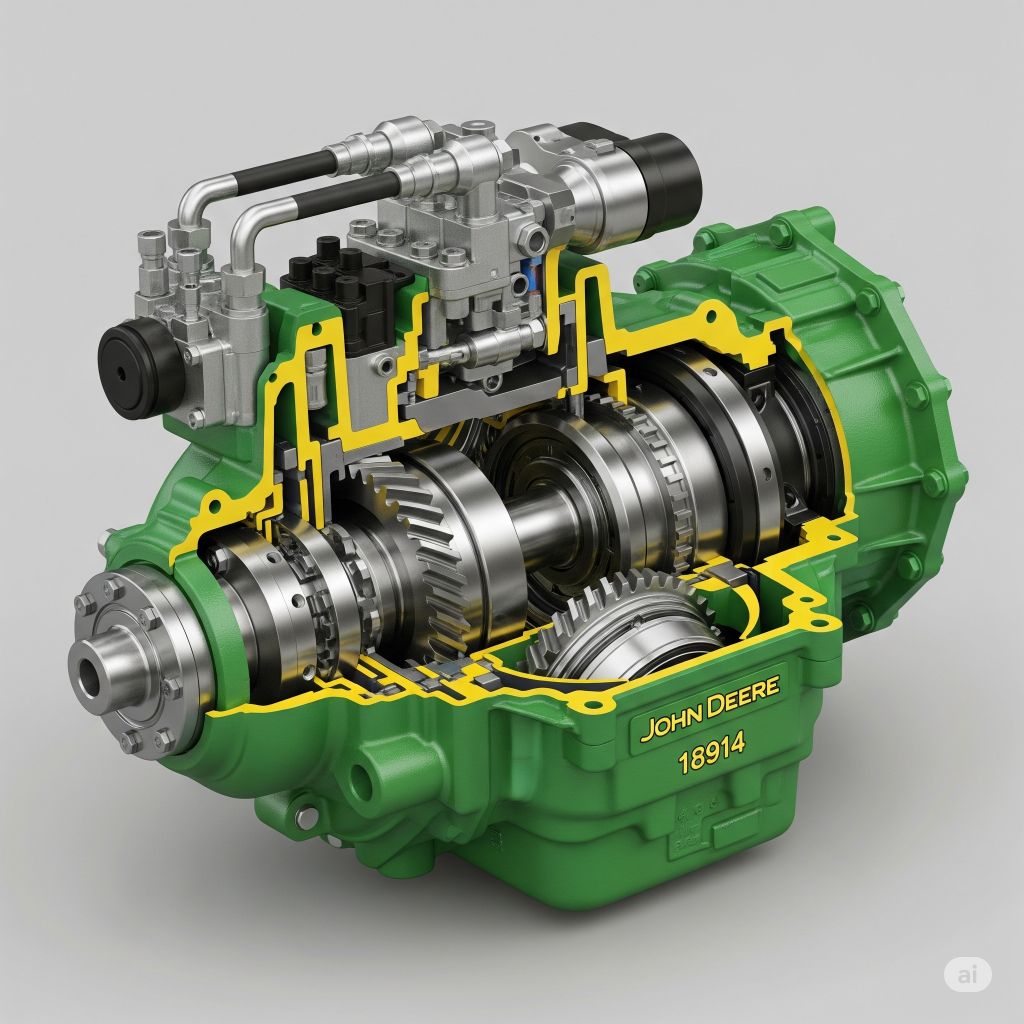
John Deere’s hydrostatic transmission system has become a staple in its lawn tractors, compact utility tractors, and zero-turn mowers due to its smooth performance and ease of operation. However, despite its engineering strengths, hydrostatic systems are not immune to wear, misuse, or time-induced failures.
This guide explores the most common hydrostatic transmission problems in John Deere equipment, their diagnoses and fixes, and tips to prevent costly repairs. Whether you operate a residential mower like the John Deere D140, a commercial ZTrak zero-turn, or a compact 1025R tractor, understanding hydrostatic issues is essential to maintaining reliable performance.
9 Common Hydrostatic Transmission Problems & Fixes
1. Cavitation (Air in the System)
Symptoms: Mower won’t move, sluggish response, jerky starts after storage (especially post-winter).
Causes: Air in hydraulic lines disrupts fluid pressure.
Fix:
- Follow your John Deere manual to purge the system:
- Park on level ground.
- Engage the parking brake.
- Disengage the transmission.
- Cycle the motion control levers full forward and backward 5–6 times.
- Repeat after warming up for best results.
2. Low or Contaminated Hydraulic Fluid
Symptoms: Poor acceleration, transmission overheating, sluggish gear shifting.
Causes: Fluid levels too low, old or dirty oil, or wrong fluid type.
Fix:
- Use Hy-Gard™ or other John Deere-approved hydrostatic fluid.
- Change the fluid and filters at the intervals recommended in the operator’s manual.
- Clean the reservoir cap before refilling to prevent dirt contamination.
3. Worn Drive Pulley or Belt
Symptoms: Engine runs but mower doesn’t move; screeching noises.
Causes: Pulley slips on the shaft or belt wear reduces torque transfer.
Fix:
- Inspect belts for cracks, frays, or shiny spots.
- Replace the drive belt and worn pulleys with OEM parts for best results.
4. Transmission Will Not Engage or Moves Sluggishly
Symptoms: Tractor doesn’t move even when you shift or does so slowly.
Possible Causes:
- Low or contaminated hydraulic oil
- Air in the system
- Broken or misadjusted control linkage
Fixes:
- Top off fluid to correct level.
- Follow purging steps.
- Inspect and tighten all linkages and mechanical levers.
5. Charge Pump Failure
Symptoms: Tractor moves but loses power under load; charge pressure light is on.
Causes: Suction leak, weak charge pump, clogged filter.
Fix:
- Test charge pressure using diagnostic tools (specs in your service manual).
- Replace worn charge pumps or clean/replace filters.
- Inspect for suction hose leaks.
6. Internal Leaks in Transmission
Symptoms: Power loss, overheating, reduced responsiveness.
Causes: Worn seals, damaged gaskets, or cracked internal components.
Fix:
- Requires disassembly and rebuild—often best handled by a technician.
- Rebuild kits available for popular models like LT155, 1023E, and 100 Series.
7. Shifting or Steering Difficulties (Zero-Turn Models)
Symptoms: Stiff steering, drifting, or uneven tracking.
Causes: Worn control valves, dirty fluid, or air in steering hydro system.
Fix:
- Clean or rebuild steering control valves.
- Purge air from the hydraulic system.
- Regularly clean control linkages and apply grease as needed.
8. Overheating and Error Codes (e.g., P0842)
Symptoms: Transmission housing is hot; unit shuts down or throws error codes.
Causes: Poor airflow, clogged cooling fins, or aged fluid.
Fix:
- Clean cooling fins with compressed air.
- Ensure airflow vents aren’t blocked by debris or grass clippings.
- Replace hydraulic fluid and filters as needed.
9. Transmission Slipping or Jerky Operation
Symptoms: Mower jerks, slips while accelerating, or feels “stuck.”
Causes:
- Dirty oil
- Loose belt
- Air in system
- Valve linkage issues
Fixes:
- Flush transmission system and refill with clean fluid.
- Tighten or replace belt.
- Adjust or replace control linkages.
🚜 Series-Wise John Deere Hydrostatic Transmission Reliability
| Series | Common Issues | Reliability Summary |
|---|---|---|
| 100 Series (D100–D170, E100–E180) | Pulley wear, belt slip, cavitation after winter storage | Moderate; low-end residential units |
| X300 Series | Charge pump wear, shifting stiffness | Above average; better design than 100s |
| X500 Series | Fluid overheating under heavy loads | High; robust systems for hilly terrain |
| ZTrak Zero-Turns | Jerky steering, hydro oil contamination | Varies by use; solid commercial units |
| Compact Utility (1023E, 2025R) | Filter clogs, cavitation, linkage issues | High reliability; service-sensitive |
🛠️ Preventive Maintenance Tips
- Check fluid levels monthly (especially before first mow of the season).
- Use only recommended hydraulic oil (Hy-Gard or equivalent).
- Flush fluid every 300 hours or as specified in your manual.
- Clean cooling areas behind seat and under transmission.
- Operate with proper throttle—don’t run too slow during climbs or loads.
- Avoid overloading or towing more than rated capacity.
- Keep drive belts tensioned and clean.
- Let machine warm up before heavy work, especially in colder weather.
🔄 A. Change Transmission Fluid & Filter Regularly
- Replace fluid every 100–250 hours (check model manual).
- Use John Deere Hy-Gard™ or equivalent
🕳 B. Air Purging Protocol
- Park level, seat engaged, neutral control lever
- Move lever fully forward for 5 sec, then reverse for 5 sec; repeat 3–7 times DillonGarden.com
- Finally, check fluid level and top up
💨 C. Clean Cooling & Ventilation Components
- Vacuum or brush debris off cooling fins around transmission
- Ensure fan blades are intact and spinning freely Nelson Tractor Company
🧪 D. Monitor Fluid Quality
- If the fluid looks very dark or watery, it may lack viscosity and lubricity—schedule full flush and filter replacement Reddit
⛓ E. Inspect Drive Belts and Charging Assemblies
- Replace worn belts, adjust tensioners
- Damaged charging pump springs can reduce pressure and cause slipping
🔩 F. Control Linkage & Freewheel Checks
- Confirm freewheel bypass lever is fully engaged before driving
- Clean the linkage pivot areas to avoid binding or misalignment
❓FAQs About John Deere Hydrostatic Transmission
Q1: How long does a John Deere hydrostatic transmission last?
Answer: With regular maintenance and proper fluid changes, many systems last 800–1,200 hours or more. Commercial units can often go even longer.
Q2: Can I repair a hydrostatic transmission myself?
Answer: Basic issues like belt replacement or purging air are DIY-friendly. However, internal hydro repairs (like rebuilding pumps or valves) usually require professional tools and expertise.
Q3: What fluid goes in a John Deere hydrostatic transmission?
Answer: John Deere recommends Hy-Gard™ Low Viscosity or J20C spec oil depending on your climate and model. Always refer to your manual.
Q4: Why does my John Deere mower stop moving after a while?
Answer: Likely causes are low fluid, a clogged filter, overheating, or belt slippage. Check all visible components and fluid condition.
Q5: Is purging necessary every time I change fluid?
Answer: Yes. Even new fluid can trap air bubbles. Purging ensures full pressure is restored and prevents sluggish operation.
✅ Conclusion
Hydrostatic transmissions on John Deere tractors and mowers are reliable workhorses—but only when well-maintained. Recognizing early signs of issues like cavitation, worn pulleys, or fluid contamination can save you from expensive repairs down the line. Whether you’re driving a D-series lawn tractor or a 3R compact utility beast, routine inspections and proper servicing are the keys to long-lasting performance.

I’m David man behind Lawn Mowerly; I’ve been dealing with lawnmowers and Tractors with my father since I was a kid. I know every make and model and what each one is capable of and love helping people find the perfect equipment for their needs.
